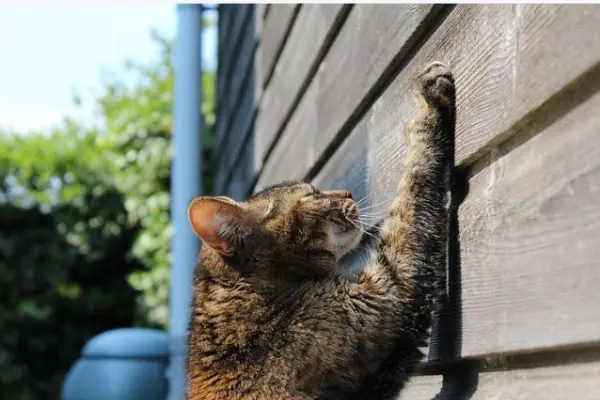10 Most Common Cat Behavior Problems & Helpful Tips

I consider myself a cat person because I have been with cats from childhood, so let’s discuss the most common cat behavior problems every cat owner should expect.
With all my years of experience living with cats, there are certain groups of behavior problems that occur in many cats, I reached out to other cat owners before drafting this post.
So what you get from this post is coming from lots of cat owners I reached out to, my experiences with cats for years, and a little online research to back it up.
So, let’s discuss…
Common Cat Behavior Problems
Here are some of the common cat behavior problems cat owners should understand:
1. Scratching furniture when bored

Cats’ excessive urge to scratch when bored is a crucial component of their behavior problem to be aware of. Boredom can lead to frustration or sadness in most cats.
Despite the fact that declawing the cat is the most efficient way to tackle this problem, some cat owners are against it.
Cat owners attempt to find ways to deflect their cats’ scratching tendency in these instances.
Keep in mind that this is a natural cat behavior, and punishing it might not go down well.
Even though most cats can be alone for lengthy periods of time because they prefer napping, they might become bored and scratch places they are not permitted to touch when they are awake.
Ways to control excessive scratching in cats
Here are some common ways to control excessive scratching in cats:
- Provide scratch post as much as you can provide.
- Provide enough engaging and interactive toys as you can.
- Never allow your cat to get bored by leaving them alone for too long unattended to.
- Provide lots of mental stimulation daily.
- If you can get a second companion cat.
- Cat proof places you don’t want your cat to enter.
- Provide a stress-free and safe room or spot with lots of scratching surfaces.
2. Separation anxiety
Most cats are highly bright and demand mental stimulation; they are not the type of pet to keep if you work a 9-to-5 job.
They like having human or animal companions, so adopting one and leaving it at home alone is a bad idea. Cats can manage separation anxiety than dogs.
If they are left alone for more than 9 hours on a regular basis, they may develop separation anxiety, and some may become violent and destructive.
Most cats can acquire separation anxiety without displaying it, which can lead to undesirable behaviors such as scratching, biting, and elimination over time.
Common signs of separation anxiety in cats include:
- Excessive meowing on owners departure or arrival.
- Eating too quickly or not at all at owner’s arrival.
- Excessive self-grooming.
- Elimination that takes place outside of the litter box regularly.
- Scratching valuables excessively on owners’ absence.
- Behavior that is harmful to others.
- Attempting to flee on owner’s departure.
How to prevent separation anxiety in cats
- Establish a working daily routine
- Exercise and play with your cat before leaving the house.
- Create a stress-free environment for your cat.
- Invest in more engaging and interactive toys.
- Invest in some antianxiety products.
- Get a second companion cat.
- See an animal behaviorist or your vet.
- To stimulate hunting instincts, hide food in toys that require them to work for it.
- Leave the radio or television on a station that you listen to frequently while you’re there.
3. Excessive vocalization
Most cat owners battle with excessive vocalization since it is one of the most frequent feline behavior disorders.
If you don’t listen to a cat when they need anything, they’ll grow enraged, clawing objects or howling.
Most cats want to be in charge at all times; if you’re standing, they won’t stop until you sit down with them.
Cats may be extremely vocal when they need something, even if it’s something they can get without you.
For various reasons, most popular cats are known to talk excessively. This happens all the time with cats, and your kitty’s behavior might be quite typical.
How to prevent excessive vocalization in cats
- Provide lots of electronic and interesting toys.
- Create a daily routine or module and stick to it.
- Start socialization and training as early as possible.
- Provide lots of mental stimulation on a daily basis.
- Invest in treasure hunt toys.
- Provide everything your cat needs.
- Make sure your cat is not sick.
- Just get use to their loud meowing.
4. Territorial and possessive behavior
Other issues with most cats’ behavior include their drive to be dominating.
The majority of cats are born with the ability to sense another cat’s fear or subservience.
Most cats can prey on or even fight with that cat in order to establish territory and authority.
This cat behavior trait is linked to the natural jealousy of most cats. Some cats even mark their territory with their scents.
This is a cat breed that expects to be the center of attention in all situations, and it will bully other animals to get it.
How to prevent territorial behavior of cats
- Never punish them for territorial behavior, or they may become more aggressive.
- Set up rules, limitations and boundaries.
- Squirt fighting cats with water or use a whistle to distract them.
- Keep a regular routine
- Visit other cat owners as often as possible.
- Socialize your cat as early as possible.
- Desensitize your cat.
- Contact your veterinarian.
5. Avoiding litter boxes
When cats are bored, annoyed, unhappy, or unwell, they prefer to avoid litter boxes, this is one of the most common cat behavior problems.
It’s most prevalent when you first bring your cat home, and it might indicate a shortage of litter boxes or a need for a cleaner litter box in their new home.
Even if they haven’t shown any signs of it before, cats might develop litter box issues when you bring a new family member home.
One cause of regular litter box troubles might be anxiety or a lack of comfort in your cat’s environment.
How to fix cats litter box issues
- Scoop the litter box at least once a day.
- Use unscented litter in an uncovered box.
- Put the box where there’s not a lot of traffic.
- Try using more than one box
- Try different litters.
- A medical problem should be investigated if your cat starts avoiding the litter box for no apparent reason.
- Reward and praise your cat for not avoiding the litter box.
- Make the litter boxes easy to access.
6. Cats enjoy waking up their owners too early
Most cat owners will recognize this as one of the most typical feline behavior issues.
Cats are known for sleeping much of the day and being active at night.
Cats frequently sleep when their owners are there. They don’t like it when their owners sleep while they’re awake.
Even if their litter box is free and close to where they slept, most cats will wake you up between 4:30 and 5:00 a.m.
Your cats will begin scratching your elbow and jumping about you till you wake up peacefully in the morning.
I just believe cats are self-centered since they will sleep while you are at work and will only wake you up when it is time for you to go.
Tips
- To avoid this type of behavior, make sure the cats have exhausted all of their energy before putting them to rest.
- Playing a late fetch game with your cat might help you avoid waking up too early in the morning.
- You may also keep your cat occupied in the morning by providing a variety of intriguing and engaging toys or any other form of distraction.
7. Play aggression
Play aggression is the most common kind of cat behavior problem, and it usually shows itself as your cat roughhousing.
If you don’t have appropriate training, your cat may engage in excessively rough play that might harm you.
When cats play, it’s sometimes difficult to determine whether they’re having fun or not. Pounce, swat, scratch, and bite are all things they do.
Scratches and bites from play still hurt. Use batting toys like balls or a fake mouse to redirect your cat’s enthusiasm.
They can have hours of joy pouncing on a paper bag. To keep yourself safe, never let a cat play with your hands or feet. As a cat matures, nips develop into bites.
How to prevent play aggression in cats
- Make careful to keep the cat’s nails trimmed to avoid the risk of damage.
- Only provide structured playtime for the cat.
- Give your cat a time-out.
- Provide a variety of toys for your cat.
- Rule out other forms of aggression.
- Never use your hands as toys.
- Don’t pull away when playing with the cat.
- Never punish the cat for aggressive play.
- Have appropriate toys for interactive playtime.
- Don’t wrestle with your cat during play.
- Provide more overall environmental enrichment.
- Distract your cat with an appropriate toy
8. Aggression
Cats are recognized for being incredibly active, lively, and spirited. They enjoy being kept active at all times.
Most cats become aggressive as a result of separation anxiety, loneliness, or a continual change of habit.
If cat aggression isn’t managed or resolved, it might develop into unnecessarily violent behavior toward other household members.
An aggressive cat might flee at any moment and become a wild cat, or it can decide to bite and nip.
How to prevent aggression in cats
- Start a mental-stimulating activity, such as puzzle games.
- Treats and food with a strong odor should be provided.
- Observe your cat for any triggers that cause it to be aggressive and remove it.
- New and engaging toys, such as the electronic fish, should be available.
- Take your cat for a stroll in the evening.
- Try recommended supplements, medications, and special diets may help from your vet.
- Spend some extra time with your cat.
- Create a clean window with a nice view of the outside world.
- Purchase a new cat tree or shelves for your home.
- Make an appointment with your vet or animal behaviorist.
9. Cats despise being picked up most times
It is a legitimate fear because your children or visitors may want to pet your cat, resulting in the cat biting them.
Cats are not violent, but they do not lap cats unless they have been properly taught and socialized.
If you don’t let them know you’re going to pick them up before doing so, they’ll bite you right away.
Tips
The majority of domestic cats have an issue with refusing to be picked up.
Whether you can pick up a cat or if a cat will allow you to pick them up relies on your bond with your cat since it was a kitten.
When your cat is a kitten, begin training them to allow others to pick them up and constantly praise them.
You may start stroking your palms on your adult cats’ backs and picking them up with the aid of treats. This method must be carried out several times.
10. Obsessive licking or grooming
Cats groom themselves to look clean and to relax. It might harm their skin if they overdo it.
Check with your veterinarian first to see if you have any skin issues or look for any symptoms of worms in cats.
If your cat is grooming excessively due to stress, such as a change in routine or the addition of a new pet to the household, soothe them by playing with them and making them feel at ease.
Tips
- Avoid pest attacks.
- Regular brushing sessions.
- Talk to a vet.
- Keep your home clean.
- Look for skin diseases.
Here you have it, the most common cat behavior problems you should know, this is not all but the major ones that most cat owners experience.
Common ways to stop unwanted behaviors in cats
Here are some helpful hints to assist you to stop your cat’s undesired behaviors:
- Recognize and treat your cat’s emotional and physical needs.
- As your cat kitten develops, assist it in developing good habits.
- Your cat must be properly socialized from the time it is a kitten.
- A second pet should be provided, either a cat or a dog.
- Don’t shout at your cat; instead, be patient and make the necessary modifications.
- Regular examinations by a veterinarian are required.
- Invest in a huge quantity of engaging and interactive toys.
- Give your cat some form of exercise every day.
- Always reward positive behavior and discourage the bad behaviors.
- Always use positive reinforcement and not bad or harsh reinforcement.

![New Cat Hiding And Not Eating [Explained] New Cat Hiding And Not Eating](https://petcreeks.com/wp-content/uploads/2023/02/New-Cat-Hiding-And-Not-Eating-768x555.jpg)
![How Do Cats Get Bacterial Infections [12 Hints] How Do Cats Get Bacterial Infections](https://petcreeks.com/wp-content/uploads/2021/03/How-Do-Cats-Get-Bacterial-Infections.jpg)

![Should I Get A Second Cat [12 Pros & Cons] Should I Get A Second Cat](https://petcreeks.com/wp-content/uploads/2023/04/Should-I-Get-A-Second-Cat-768x555.jpg)
![Why Does My Cat Stare At Me While I Sleep [Explained] Why Does My Cat Stare At Me While I Sleep](https://petcreeks.com/wp-content/uploads/2022/11/Why-Does-My-Cat-Stare-At-Me-While-I-Sleep-768x555.jpg)
